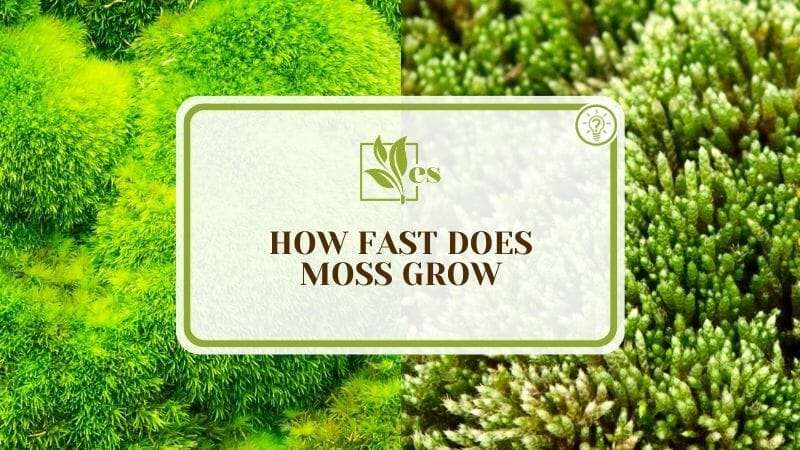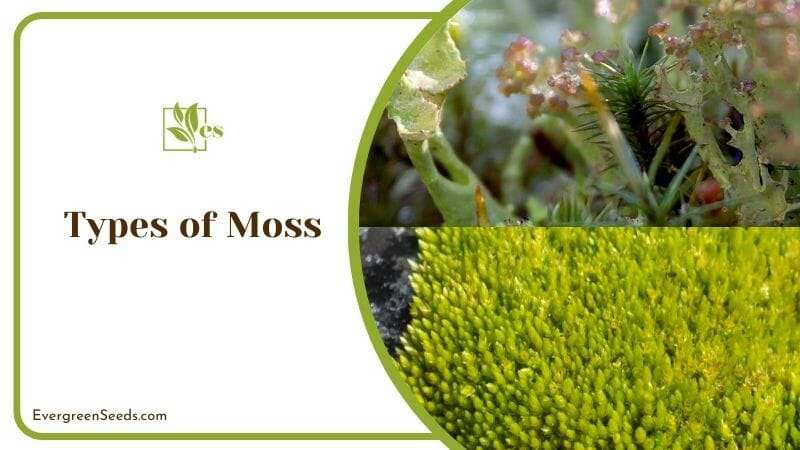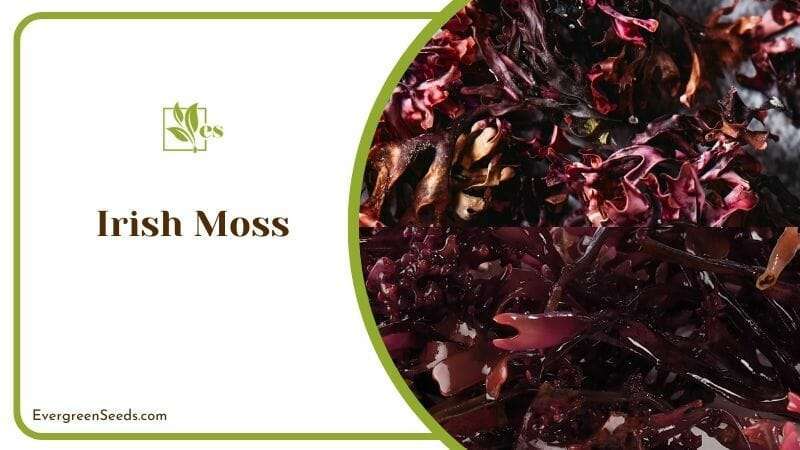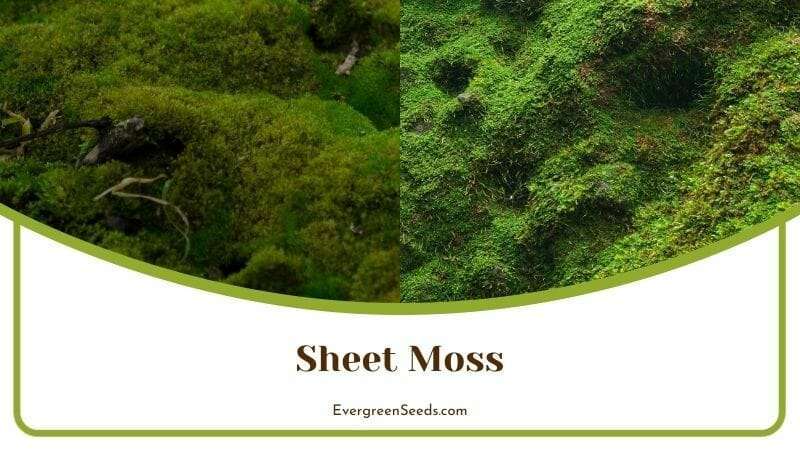How fast does moss grow might be the least of your concerns if you have its general perception – dirty and unkempt. Moss is a low-maintenance and pretty-close alternative to grass. It adds a decorative touch irrespective of where it is placed.

Most people are excited about moss in their yards, but the thought of how long it would take to grow keeps them back.
JUMP TO TOPIC
- How Fast Does Moss Grow?
- What Are the Factors That Determine the Growth Rate of Moss?
- What Are The Categories of Moss Growth Speed?
- Where Do People Grow Moss?
- What Is the Best Time to Transplant Moss?
- How Long Does It Take for Moss To Grow on Bricks and Rocks?
- What Are the Different Types of Moss, and How Long Do They Take to Grow?
- Is There a Way to Increase Moss Growth?
How Fast Does Moss Grow?
💥New moss grows at the rate of a few days to a few weeks. It depends on the type of moss you are growing. There may have been a time when you wondered how long it takes to grow moss and it has held you back from getting your own.
Unlike most other plants, moss does not grow any flowers or seeds. rather, it reproduces by releasing spores in the air. Before growing, these moss spores like to settle on moist surfaces first.
If by chance you get a hold of a spore, keep it in a plastic bag or container lined with a wet paper towel that you spray with water daily. You will see the spore germination within three to six days with the right growing conditions. However, some mosses may take weeks or even months to establish fully.
What Are the Factors That Determine the Growth Rate of Moss?
The factors that determine the growth rate of moss are the types of moss, among other things, but the type is the deciding factor. Moss can take as little as six weeks and as many as two years to flourish.
Irrespective of the natural growth rate of moss, some factors can enhance its growth rate. These factors apply to all moss types and are mentioned below.
– Types of Moss
There are over twelve thousand types of moss meaning there is no fixed growth rate. Some types have a fast growth rate, while the rest do not. For example, the common Sphagnum Moss grows approximately less than one to around five inches per year, while Irish Moss, having a comparatively faster growth rate, can grow up to twelve inches per year.

The presence of other plants nearby can hinder the moss growth rate. If these other plants have a fast growth rate, moss will have a hard time growing at a fast rate.
– Water and Light Availability
Water availability is a high determinant of the moss growth rate. Moss grows rapidly in moist environments with high humidity levels. A dry environment leads to a slow growth rate that can lead to moss death.
The availability of light helps moss to absorb carbohydrates. However, too much light can be harmful to moss growth. Moss grows denser and faster in shaded areas.
– Temperature and Growing Surfaces
Temperature plays a vital role in determining moss growth. Moss grows in moderate to cool temperatures, approximately five degrees Celsius.
Growing surfaces, like soil or hard surfaces, significantly determine how quickly mass grows. Usually, it is grown on soil, water, rocks, concrete, bricks, and pots.
What Are The Categories of Moss Growth Speed?
The two categories of moss moss growth speed are the faster type and the slower types. They produce in very different ways and therefore have vastly different growing times. In general you can count on “slow and steady” with moss.
– The Faster Types – Pleurocarpus
Mosses in this category grow in a spreading mat formation. They establish new growth in approximately three months when provided with adequate sunlight, acidic soil, moisture, and shelter.
They reproduce through fragmentation, where moss pieces get detached from the main clump. Fragmentation can be artificial and can have a natural occurrence in rough weather conditions. Due to their fast-growing nature, they quickly adapt to new environments and double in size in six months.
– Acrocarpus – The Steady Ones
Acrocarpus mosses grow vertically with a single stem, deprived of branches and offshoots. They have a slow and steady growth rate. In some cases, they make take up to two years to form.

They need help attaching to a substrate and can take as long as six months to attach fully. However, only one year has passed before they begin to grow and mature.
Where Do People Grow Moss?
Many people grow moss in their yards instead of grass. Moss is low maintenance, and light on water. Moss benefits the environment and adds to the landscape design. If you want to grow moss on soil you can take moss growing in your garden, neighborhood, a nursery or go online.
For optimal results, pick moss from an environment similar to the environment you intend to plant. You will need a rake, a garden spade or knife, and a few rocks.
When you find the moss capable of adjusting to your environment, use the garden spade to loosen it up from the ground as much as required. Please take it to its set destination. And before you lay it down, use a rake to make new soil and create an even and flat surface.
Now, if you are sure of the location for placing the moss, press it down firmly and place rocks over it, so the moss is in direct contact with the soil. The filaments of moss need to be absorbed by the soil to thrive.
Keeping the soil moist in the next six weeks is essential to the transplanting process. You will know that it has made its way to the soil and is thriving when you fail to remove it with a slight tug.
What Is the Best Time to Transplant Moss?
Moss can be transplanted throughout the year. But the most appropriate times to plant moss are late March to mid June, spring, and September to November – the fall season. However, moss can be grown in months like July and August, even though the hotter months are better for transplanting moss.
This can be made possible by installing sprinklers at the sites where you wish to transplant the moss. Leafless, huge trees play a huge plant in making the transplant process a success in hotter months as they provide shade to the moss. Watering the plant in such months is also fine.
How Long Does It Take for Moss To Grow on Bricks and Rocks?
Moss grows on opaque objects. Like bricks, rocks, and trees, it loves to grow in the wild in damp and shaded areas. It does not grow well on stone walls or some types of rock. Being acidic in nature, rocks are a source of attraction for various moss forms.
Rugged and sandy rocks are the best kind of rocks for growing moss. They have water-retaining properties and promote aeration as well.
It is important to let the sandy rock soak in water for a good few days to absorb a considerable amount of moisture.
The process of transplanting moss on rocks, or bricks, is natural, requiring patience, effort, and time. To get the job done, you will need luck and tools to stick the moss and high hopes that it adapts to the new environment.
To get the best growth rate results, place moss mixed with water, buttermilk, or beer. It will show evident results within six weeks. Other than rocks, the slurry can be used on paving stones.
What Are the Different Types of Moss, and How Long Do They Take to Grow?
The different types of moss are Java, Spanish, Irish, Christmas, Scotch, Sphagnum, and Sheet. As we mentioned earlier, moss growth rate depends mainly on the species: some have a fast growth rate while the rest have comparatively slow growth rates.
– Java Moss
Java moss grows as a vigorous moss, and before you know it, a month has gone by, and you are looking at a fully established moss garden. This species of moss grows on lands and solid surfaces in a tropical climate. However, it has faster growth in water. Under optimal conditions, Java grows one to one and a half inches per month.

It is a favorite among aquarium hobbyists, but its growth rate is slower than other aquatic plants. Java makes a beautiful carpet for your aquarium.
Java is a very rugged moss, making it impossible to get rid of it that thrives in low light conditions. Common names for Java are Triangular Moss, Singapore Moss, Mini Moss, and Dubious Bladder Moss.
– Spanish Moss
Spanish Moss has a very slow growth rate, so much so that it gets difficult to notice. It grows to about one centimeter in six to eight weeks. But do not be fooled. Once it develops, it can have an annual growth of ten to twenty centimeters.
The maximum height that Spanish moss can reach is five feet, having a beautiful canopy. You will see it mostly growing on specific trees like oaks and yaupon trees. It grows best on well-draining surfaces and requires proper air circulation and backhanded sunlight. Other common names for Spanish Moss include Black Moss and Long Moss.
– Irish Moss
It has a fast growth rate allowing it to spread several feet within six to eight weeks. This species requires high humidity levels to grow at its best speed.

You can find it easy to grow in humid areas and high-rainfall regions such as tropical regions. Another name for it is Carrageen.
– Christmas Moss
Christmas Moss has a moderate growth rate. It takes a good six to eight weeks for it to reach maturity. This moss does not grow too tall and prefers average to cool climate conditions.
It is often confused with Java because of its appearance and growth rate. Christmas moss grows more horizontally and thick than Java and is slower in reaching maturity. Other common names for Christmas moss are Xmas Moss and, in Japan, Brazilian Willow Moss.
– Scotch Moss
Scotch Moss, or Scottish Moss, grows up to two to three inches yearly. It needs almost a year to spread and form a thriving mat. It remains stagnant if deprived of afternoon sunlight and sufficient water supply.

The moss has an average life expectancy of eight to ten years, provided the growing conditions are fulfilled. It is a low-maintenance plant, meaning it does not require much pruning.
Scotch Moss grows best on rocks and stones. If you plan to make it a part of your soil, you would want to add compost to the soil for better water retention.
– Sphagnum Moss
Sphagnum Moss has a very low growth rate. It takes nine months for it to reach maturity. The maximum rate it can grow is nearly five inches per year. It has a sponge-like structure and can hold up to eight to nine times its weight.
This plant is nutrient-rich, and because of this characteristic, it serves as a growing medium for various other plants. The moss can be grown in both soil and water, but better in water. Furthermore, it needs sufficient sunlight and water to grow its best.
– Sheet Moss
Sheet Moss is a more adaptable moss with a fast growth rate, making it a suitable option for covering grounds. It only takes six weeks for it to grow and attain maturity. The species can adapt to every environment in both lights to full sunlight.

The moss can survive in less humid regions, unlike the other moss types. Its common and favorite habitat is forest floors. Sheet Moss forms a sheet-like spread on the soil and rocks, hence the name.
Is There a Way to Increase Moss Growth?
There are ways to increase moss growth. Firstly, you must ensure that the species you are planning to grow is adaptive to your environment. As we discussed, most moss species prefer to grow in places with high humidity levels, while few prefer moderate to cool climates and low humidity levels.
Moss loves water. Adequate watering ensures healthy growth, but watering the moss beyond its needs may cause the plant to rot. Furthermore, planting your moss in a shaded area can help it grow faster. Fertilizers rich in nutrients like calcium, phosphorus, and potassium help the moss to thrive.
Final note:
So, there you have it! Where it is hard to pinpoint the precise timescale for the growth rate of moss, it can be narrowed down to its various species. You can grow moss indoors with spores in a plastic bag or container.
References
- MICHELLE Z. DONAHUE. (MAY 20, 2017). Fast-Growing Moss Is Turning Antarctica Green. National Geographic.
Retrieved from https://www.nationalgeographic.com/science/article/antarctica-green-climate-moss-environment - Heino Lepp. (15 April, 2008). What is a moss?. Australian Bryophyte.
Retrieved from https://www.anbg.gov.au/bryophyte/what-is-moss.html - (27/03/2018). Sphagnum Moss – Sustainable Use and Management. Department of Natural Resources and Environment Tasmania.
Retrieved from https://nre.tas.gov.au/conservation/flora-of-tasmania/sphagnum-moss-sustainable-use-and-management












